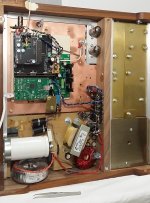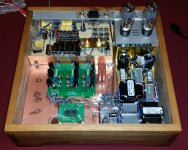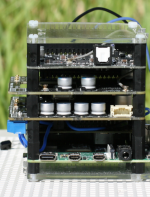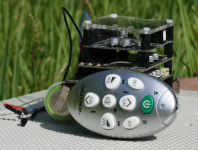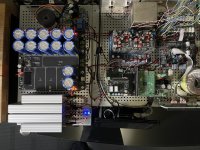Just my 2 cents......
All good points... We are all welcome to our preference.
And it is like spice. We all have our favorite recipe.
A couple of points however. If you look at Rpi, FifoPi, ReclockPi and count the total number of caps. Big number. I add 2 or 3 to each and to my ear in my room see a worthy improvement in sound. Is it all one type? No. May there be better recipes? Sure. But for the amount of time I want to invest, this works fine.
I have tried supercaps on all these devices. No doubt it has an impact that is fine. But I find a BG F makes a similar impact without the hassle. So I end up with this combination. I have them both in my parts bin. as well as many others. I choose the ones I like best for my ear after trying a few. It is all good.
StationPi in the house
Finally heard impact of StationPi on sound quality. Pleasantly surprised. You are correct. Much quieter. Also cured some persistent ground loop noise that was not bad enough to chase, but great to be exorcised.
Not just quieter noise floor, but continued step in direction of my goals. Natural sound and micro details. The sound stage changed. Not bigger, but more natural.
StationPi makes sense just for the isolation of the Rpi. I also like it just to organize the lego set a bit more logically. I did not expect the improvement in sound. That's a bonus.
Mine is a relatively simple implementation of Iancanada streamer with TDA1541a DAC and Lampizator output. The modular chassis has served well. Four separate isolated boxes in one kit for PS, DAC, Triode output, and streamer. But simple compared to many here as I have not used batteries or supercap conditioners. Bottom side is Ian's streamer lego kit. Above are the rest.
Good luck with the swap and let us know how it works out...
Finally heard impact of StationPi on sound quality. Pleasantly surprised. You are correct. Much quieter. Also cured some persistent ground loop noise that was not bad enough to chase, but great to be exorcised.
Not just quieter noise floor, but continued step in direction of my goals. Natural sound and micro details. The sound stage changed. Not bigger, but more natural.
StationPi makes sense just for the isolation of the Rpi. I also like it just to organize the lego set a bit more logically. I did not expect the improvement in sound. That's a bonus.
Mine is a relatively simple implementation of Iancanada streamer with TDA1541a DAC and Lampizator output. The modular chassis has served well. Four separate isolated boxes in one kit for PS, DAC, Triode output, and streamer. But simple compared to many here as I have not used batteries or supercap conditioners. Bottom side is Ian's streamer lego kit. Above are the rest.
Attachments
The SinePi is almost down. I re-design the PCB for 7 times until I'm happy with the result. Too many jobs to get the best performance.
I'm trying to make it available soon. The only thing I'm concerned about is the cost for such a low quantity production. But no worry, I'll figure it out.
Good weekend.
Ian
+1 SinePi for me
No. ReClockPi powered by the 3,3V FifoPi clean side by default. It can also be upgraded to independent 3.3V power supply for even better performance. Ultracapacitor or LifePO4 power supplies are recommended.
Regards,
Ian
Ian, in order of power supply quality how would you rank requirements for the below? I am running a FifopiQ3 (RPi free), bridgepi for Amanero USB and reclockerpi. I plan to power the bridgepi 5v separately eventually but now am powering:
1) FifopiQ3 J5 3.3V
2) FifopiQ3 J3 5v
3) Reclockpi 3.3v
If I power bridgepi directly do I still need to power Fifopi 5V supply (or is powering Fifopi 5v the same as powered bridgepi directly is nothing else is connected)? What does each of the Fifopi 3.3v and 5v supplies power? Is the 5v not needed if not using an RPi and everything else is powered separately?
Last edited:
Ian, in order of power supply quality how would you rank requirements for the below? I am running a FifopiQ3 (RPi free), bridgepi for Amanero USB and reclockerpi. I plan to power the bridgepi 5v separately eventually but now am powering:
1) FifopiQ3 J5 3.3V
2) FifopiQ3 J3 5v
3) Reclockpi 3.3v
If I power bridgepi directly do I still need to power Fifopi 5V supply (or is powering Fifopi 5v the same as powered bridgepi directly is nothing else is connected)? What does each of the Fifopi 3.3v and 5v supplies power? Is the 5v not needed if not using an RPi and everything else is powered separately?
BordgePi doesn't need a power supply. But FifoPi needs a 5V on Pi side.
Regards,
Ian
@jimk04 They are Salas shunts. I tend to reuse parts where possible. These supply +5,-5-15V to TDA1541A as well as +5 in the lower section which acts as a prereg to the clean side of FIFO and Reclock. Then Ians reg on ReclockPi. I used a zener emitter follower for the dirty side of FIFO and a high current 7805 to Rpi. So nothing fancy, but seem to do the job. Part of the clean up with StationPi was to build a better supply for Rpi. The big can cap on the underside contributes to 85mF CRC filter which can supply very low ripple.
@iancanada - thankyou. I use a simple 60r resistor IV. The key is a very good resistor. I wind my own manganin non inductive resistors for the I/V and the resistors in the triode output amps. Makes a surprising difference. The photo of the top side is a little dated. It now uses some nice copper coupling caps from Miflex. Again, I am very impressed with the sound your FIFO system is producing.
@iancanada - thankyou. I use a simple 60r resistor IV. The key is a very good resistor. I wind my own manganin non inductive resistors for the I/V and the resistors in the triode output amps. Makes a surprising difference. The photo of the top side is a little dated. It now uses some nice copper coupling caps from Miflex. Again, I am very impressed with the sound your FIFO system is producing.
I'm trying different SinePi power supply solutions now. I'll share the results once I have.
Hello,
I think the people who will get the Sinepi once it is available will also '' go the extra mile '' to give this tiny board its own power supply.
I wont have the space for a pair of 3000F caps.
I am waiting for an old coworker to lasercut some stainless steel '' metal work '' My lifepo4 board will offer 5 Volt with an UcCondtioner board, and 4 separate 3,3 volt lifepo4 cells ( 3 of them with a UcHybrid board)
SO probably i will have enough to '' feed '' everything properly.
Greetings, eduard
Thanks for the reference to the PS @A123.
I am a fan of the old Blackgate caps around digital. I still have a good supply from when they were cheap. I used the optional cap spot to put in some BG F and BG N. I got everything up and running today on the bench. Just finished listening to a couple of tracks using headphones on a commercial amp. Even with an NDK SDA clock and Denon amp it sounds very promising. I'll swap it into the audio room with proper clock and amps tomorrow and get a good listen.
@A123,
If non having Black Gate that are NLA or hard to find. I found sometimes Cornell DUblier FCA Acrylic smd caps were a good substitute - while not as good/ different- sometimes for decoupling purpose VS a BG Std. I know IanCanada used such tech underneath the FiFOPI with the Rubycon equivalent, but I have no experience with it. The Panasonic SMD equivalent technology is not sounding as good from a subjective hearing point of view on power supply lines. Anyway this little FCA cap can be found in 0805 size and with a main Panasonic 47 uF SEP near the load or better APSA100ETD470MFA5S gives a good combo enough for digital, than can be heard in the final sounding result often.
It is never a good idea to use one type of cap for everything. Each component has it’s own sound signature due to the construction and used materials. Using the same caps everywhere will push this sound signature to the front.
Black gate is fantastic if you use the right types on the right spot. I still have a small box of them waiting for the final stage of some of my designs (which can take some time....)
And paper in oil for is the perfect choice for power supply in tube stuff (western electric if you can find them) together with the unbeatable BG WKZ.
But for available electrolytic caps my choice is Elna Silmic for analogue and oscon for digital.
These are both very good but do not try to use them in the wrong place, oscon in analogue is not good, just as silmic in digital.
And then we have the ultracapacitors, unlocked to use safely with the nice boards of Ian. These are best in ps of digital and hf (like clocks) places.
Film caps are a separate (and much more elaborate) story.
Just my 2 cents......
Surf's Up Dudes, I wasn't aware this was a thing. I just elected for the recommended capacitors in the Manual.
It's definitely something I will re-visit down the road after the honeymoon period.
A123, which OS is on your Pi? Thanks.
I'm running AudioLinux which is a non-free product. It's a tweaked out minimalist ArchLinux build. It's clean, stable and works wonders with the RPi. The system has stepped into Pro Audio territory, not consumer, after moving to this OS.
AudioLinux - The audiophile realtime plug & play operative system
I was skeptical at first and don't know if I would of initially paid full price for the RPi version, but during my 12V PC stage I bought a PC copy at full price. Afterwards, another copy is only half price. I think it's worth it as if one were to research and try to optimise their own system with a minimalist ArchLinux build, it would cost more than the retail price. I would not go back to a free Audiophile OS. Although I'm grateful for free Audiophile OS which contributed to my learning curve. Once purchased, you can spawn multiple copies if you have >1 RPi as the license is for personal household use and not per RPi.
After experimenting with the PC version of AudioLinux, I was ready to return to USB. I was glass optical only, but AudioLinux has shifted that so looking forward to a future PC build.
Years ago, it was known that ArchLinux turned $1000 NUCs to compete and bests with $7500 commerical offerings.
Audiolinux Server configurations, Software, Hardware, and Listening Impressions - Music Servers - Audiophile Style
I believe Euphony which copied the minimalist ArchLinux blueprint and cost 5X more is the hotter ticket these days because it has more bells and whistles (upsampling, etc). No RPi version. It wouldn't make sense anyways as no bells and whistles better for RPI.
EUPHONY AUDIOPHILE OPERATING SYSTEM • Audiophile operating system, pre-installed on Euphony Drive
Since Ian's systems are pure (LiFePO4 batteries and I2S with no USB contamination), I think combining with AudioLinux is the perfect marriage.
I do optimise so I need RPi 8GB. 3-4GB to load the OS into RAM and another 4GB for the Squeezelite AudioPlayer Buffer.
I definitely feel my little transportable can compete with the expensive commercial offerings after moving to AudioLinux. It's just a dream to have this much power in such a small package. If AudioLinux was not available for the RPi, I would of likely switched over to a 12V PC solution just so I could run AudioLinux. Fortunately, since the RPi is pretty powerful these days, a RPi AudioLinux option was released.
[Photo Attachments]
I'm in the middle of configuring IR Triggers and Hotspot, so please excuse the mess. I'm running the optional Ian GPIO terminator on top so the top lid is not level.
Attachments
Last edited:
Finally heard impact of StationPi on sound quality. Pleasantly surprised. You are correct. Much quieter. Also cured some persistent ground loop noise that was not bad enough to chase, but great to be exorcised.
Not just quieter noise floor, but continued step in direction of my goals. Natural sound and micro details. The sound stage changed. Not bigger, but more natural.
StationPi makes sense just for the isolation of the Rpi. I also like it just to organize the lego set a bit more logically. I did not expect the improvement in sound. That's a bonus.
Mine is a relatively simple implementation of Iancanada streamer with TDA1541a DAC and Lampizator output. The modular chassis has served well. Four separate isolated boxes in one kit for PS, DAC, Triode output, and streamer. But simple compared to many here as I have not used batteries or supercap conditioners. Bottom side is Ian's streamer lego kit. Above are the rest.
Cheers. It gives me motivation to resurrect the StationPi in the Autumn. Mouser back-ordered parts for Desktop build should be arriving end of August.
Redbook Rules!
Last edited:
I'm trying different SinePi power supply solutions now. I'll share the results once I have.
Hello,
I think the people who will get the Sinepi once it is available will also '' go the extra mile '' to give this tiny board its own power supply.
I wont have the space for a pair of 3000F caps.
I am waiting for an old coworker to lasercut some stainless steel '' metal work '' My lifepo4 board will offer 5 Volt with an UcCondtioner board, and 4 separate 3,3 volt lifepo4 cells ( 3 of them with a UcHybrid board)
SO probably i will have enough to '' feed '' everything properly.
Greetings, eduard
Hello Ian,
Read my mail as a extra '' push '' to share some results.
Doede send me a mail yesterday and told he also dexcided to go for the eaton big F cap i am using.
Greetings, eduard
I'm running AudioLinux which is a non-free product....
Thank you A123!
Is it easy to use as a upnp device?
I Pi3b sufficient, or is Pi4 needed?
Cheers, Ernst
Last edited:
@ernesternest : Yes ! it's support UPnP
AudioLinux - The audiophile realtime plug & play operative system
Raspberry release notes
AudioLinux - The audiophile realtime plug & play operative system
Raspberry release notes
An externally hosted image should be here but it was not working when we last tested it.
Thank you A123!
Is it easy to use as a upnp device?
I Pi3b sufficient, or is Pi4 needed?
Cheers, Ernst
I only use full album WAV (single file) w/ id3 tags and embedded album art, so I'm not familiar with the other technologies only internal storage. I just keep it as simple, easy to cleanly manage and shortest path as possible.
You can contact Piero @ audiolinux@fastmail.fm to find out about UPnP use. His whole business model is based on consulting and supporting his audio software so I'm sure he will be happy to answer your questions. He has a reputation of great support and responsiveness. He's based in your time zone +-1 (Italy) so you should receive a prompt reply.
I believe this is his account here, but he doesn't DIY much anymore:
@blackhole
If he did DIY, maybe Andrea and Piero could team up (Italy connection) to optimise Andrea's upcoming DAC. Although I moved on from that R2R / NOS stuff a long time ago and Piero works on that No DAC is the best DAC project.
Unfortunately, RPi3 is not supported or updated anymore. Piero froze RPi3 at release 1.5.0, so IMO a RPi4 is necessary.
The latest release (2.1.0) notes is here:
Raspberry release notes
If you are seriously interested, I recommend to lock up the price this month (59 Euros / Dollars). The money you save can go towards an RPi4.
For example, if the price increase in August moves to 89 or 99 Euros / Dollars, that 30 or 40 Euros / Dollars saved can goes towards a new RPi. So about 3-4 days left before the price hike.
Decent value considering Euphony is 249 Euros and 299 Dollars, but upsampling is a whole other rabbit hole. After the AudioLinux price hike, I won't consider it of good value anymore but it gets closer to the competitor's (maybe knocked off AudoLinux) pricing.
If you plan a future PC build along with a present RPi4 build, it will run about 89 Euros / Dollars until the end July. I paid 59 Dollars for the PC version (planned future use) and only had to dish out 30 Dollars for a additional RPi so it was easy to justify. I justified the purchase as a educational expense because it helped me enhance my audio education and saves me loads of time trying to optimise software on my own.
Plus I currently run 3 RPi for audio so it breaks down to $10 each. Without the package (PC + RPi), that breaks down to about $20 for each RPi which makes it easier to justify if you plan >1 RPi.
Last edited:
@ernesternest : Yes ! it's support UPnP
@linh0983, your awesome. Did not have a clue you were a AudioLinux user. Well played M8.
- Home
- Source & Line
- Digital Line Level
- Asynchronous I2S FIFO project, an ultimate weapon to fight the jitter
